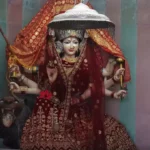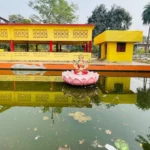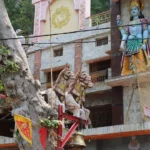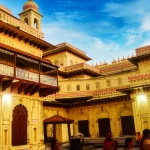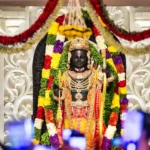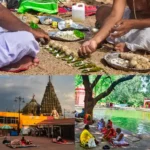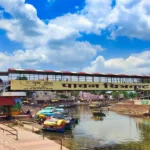Pilgrimage and Tourism
The Shakti Peethas in Uttar Pradesh are not only spiritual sanctuaries but also significant landmarks that attract a blend of pilgrims and tourists, each seeking their own experience amidst these ancient stones. These temples, steeped in legend and history, offer a unique journey through India’s rich spiritual and cultural heritage.
Visiting the Shakti Peethas:
Accessibility: Most of these sacred sites are accessible by road and are connected to major cities through a network of highways. The nearest airports and railway stations are usually not too far away, making these temples reachable for both domestic and international travellers.
Best Time to Visit: While these temples can be visited throughout the year, the months of October to March are considered ideal due to the pleasant weather. However, visiting during prominent Hindu festivals like Navratri and Maha Shivaratri can be a uniquely enriching experience, albeit more crowded.
Accommodations: There are various accommodation options ranging from basic dharamshalas to luxurious hotels, catering to the needs of the budget traveler as well as those seeking comfort and luxury.
Festivals and Fairs:
Each Shakti Peetha celebrates numerous festivals with great fervour. Navratri, particularly, is celebrated with immense zeal, marked by special rituals, fasting, and an array of cultural performances.
The Kumbh Mela in Prayagraj, close to the Prayag Shaktipeeth, is a spectacle in itself, drawing millions of pilgrims from across the globe.
Local Cuisine and Crafts:
Visitors can savour the local cuisine, which is a delightful blend of flavours and spices, typical of North Indian fare.
The regions around these temples are also known for their unique handicrafts, textiles, and souvenirs, offering tourists a chance to take a piece of local artistry back home.
Pilgrimage Services:
Many of these temples provide facilities like guide services, pooja arrangements, and assistance for special darshans, ensuring that the spiritual and religious needs of the pilgrims are well taken care of.
Language is not a barrier, as guides proficient in various languages are generally available to assist international tourists.
Tourist Information Centers:
Tourist information centres, often located in proximity to the temples, provide valuable information about the temple’s history, timings, and nearby attractions.
These centres also offer insights into local customs and practices, helping tourists navigate the cultural landscape of the region with ease and respect.
The pilgrimage to the Shakti Peethas in Uttar Pradesh is not just a journey to a religious destination; it’s an immersive experience that offers a glimpse into the soul of India. Whether it’s the spiritual ambience, the architectural grandeur, or the cultural richness, these sites promise a multifaceted exploration of faith, heritage, and tradition.
Cultural Impact
The Shakti Peethas of Uttar Pradesh are not merely spiritual epicentres; they are cultural powerhouses that significantly influence the local customs, traditions, and even the economy. The presence of these sacred sites deeply permeates the social fabric of the region, shaping its identity and community life.
Influence on Local Culture and Traditions:
Religious Practices: The daily rituals and annual festivals at these temples set the rhythm of life in the surrounding areas. Rituals like aarti, bhajan, and kirtan are not just religious practices but also social gatherings that foster community bonding.
Art and Music: Many of these temples have been centres of classical music, dance, and art forms for centuries. They often host cultural events, drawing performers and artists from various parts of the country, thereby keeping traditional art forms alive.
Impact on Local Economy:
Tourism: The influx of pilgrims and tourists significantly boosts the local economy. From hotels and restaurants to vendors selling religious paraphernalia and local handicrafts, a wide range of businesses thrive.
Employment: These temples and the associated tourism generate numerous employment opportunities for the locals, ranging from priests and temple caretakers to guides, shopkeepers, and service providers in the hospitality sector.
Community and Social Services:
Many temples actively engage in social welfare activities, including running educational institutions, healthcare centres, and community kitchens (langars or bhandaras), especially during festivals and fairs. These services not only support the underprivileged but also reinforce the temples’ roles as community centres.
Conservation and Heritage:
The maintenance and preservation of these ancient temples are pivotal in conserving the architectural and cultural heritage of the region. Efforts by local authorities, religious organizations, and sometimes international bodies ensure that these relics of the past stand tall for future generations.
Awareness about the historical and cultural significance of these sites is also spread through various initiatives, encouraging responsible tourism and community participation in heritage conservation.
Unique Rituals and Practices:
Each Shakti Peetha has its own set of unique rituals and traditions, reflecting the local folklore and customs. These practices are not just religious activities but are also a window into the region’s history, myths, and collective psyche.
Cultural Exchange:
These temples serve as melting pots where people from diverse cultural, regional, and social backgrounds converge, leading to a rich exchange of ideas, beliefs, and customs. This cultural exchange promotes mutual respect and understanding, contributing to the pluralistic fabric of Indian society.
The Shakti Peethas of Uttar Pradesh, thus, are pivotal in nurturing and propagating the cultural, social, and economic dimensions of the region. They stand as symbols of unity and continuity, bridging the past with the present, and fostering a collective identity rooted in spirituality and cultural richness.










